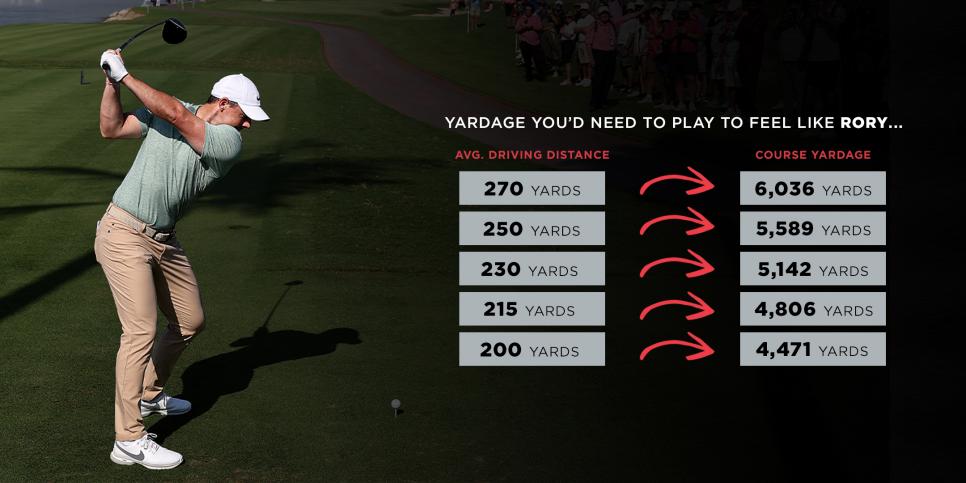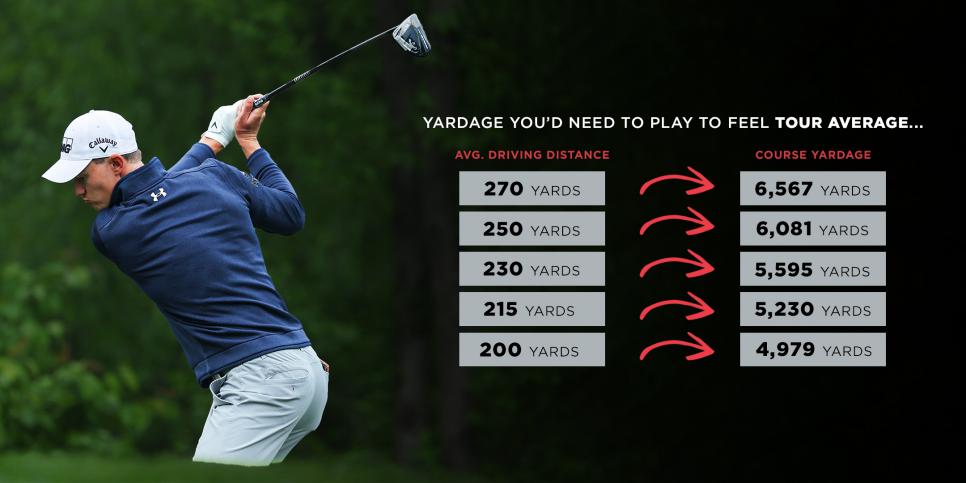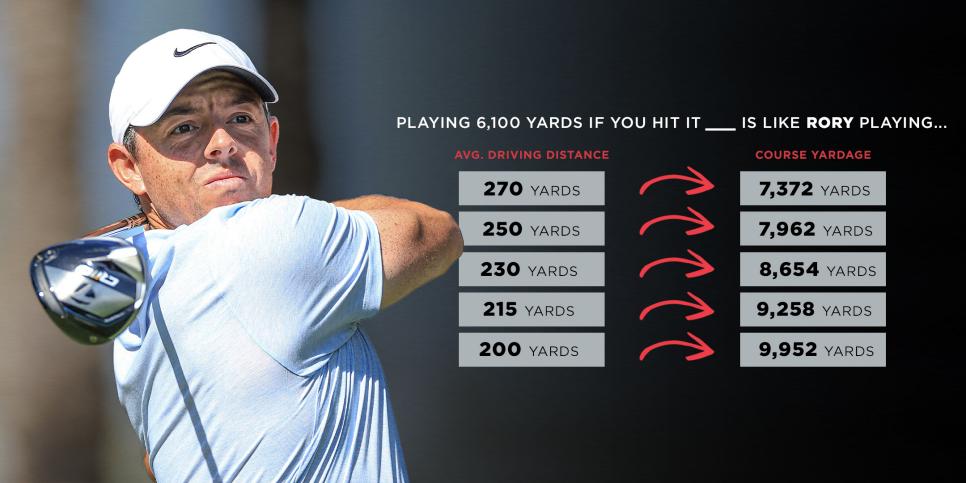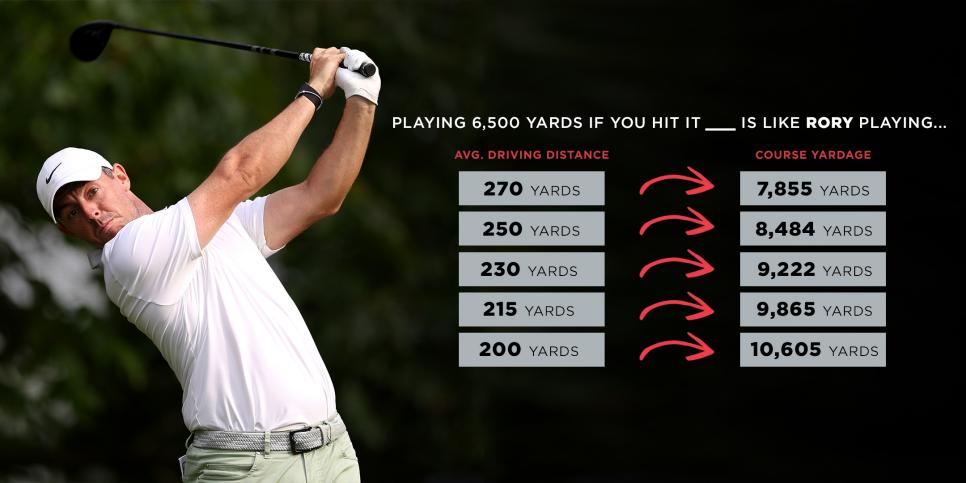Proponents of the golf ball rollback argue that professional golfers hit the ball too far, causing the game to place too much emphasis on distance and rendering classic designs defenseless. Those who oppose a universal rollback—which will take effect for pros in 2028 and for everybody else in 2030—believe that the move will rob average golfers of much needed distance, as most courses are already too long for them.
Could both sides be right? We crunched some numbers to contextualize just how short courses play for pros and how long they play for the rest of us. The results are astounding and can be taken two ways: Either tour pros need to play much longer courses or we need to move up a set of tees . . . or three.
Last year on the PGA Tour, the average course was a shade under 7,300 yards and the average driving distance was about 300 yards. Rory McIlroy led the tour in driving distance, averaging 326 yards per drive. Most of us will never be able to hit it 330 yards, but we can play an appropriate tee box that would make a course feel as it does for Rory.
Measuring driving distance as a percentage of total yardage
Time for a little math. McIlroy’s 326-yard average is 4.473 percent of the length of an average tour course. So, for us to play a course that feels like a normal tour course does for Rory, our average driving distance should be 4.473 percent of the total yardage.
Before we crunch the numbers, you need to determine your average driving distance. Be honest with yourself. This isn’t a measure of how far your best drives go, but the good and the bad together. Keep in mind these statistics, taken from our How You Compare interactive, where you’ll see the average driving distance for each handicap. (The tour data in the interactive was taken from 2022, when Cameron Champ led the tour in distance.)
OK, let’s start with the bombers amongst us—those who average 270 yards, or nearly 10 yards more than the average scratch golfer. For those players to make a course feel like it does for Rory, they would need to play from … 6,036 yards.
If that sounds incredibly short, it is. Those longest players are likely used to playing the tips, anywhere from 6,500-7,000 yards. For those who average 250 yards off the tee, you’d need to play from 5,589 yards for a course to feel like it does for Rory. Check out the complete breakdown below.

Either our second shots are too long . . .
Keep in mind that the average driving distance for a 15 handicap is just under 220 yards. That’s roughly the average for all male golfers. For those players to play a course the way Rory does, they would need to play from around 5,000 yards.
That is extraordinary, considering data from the USGA finds that the male golfers, on average, play from 6,089 yards. To play golf like a tour bomber, you don’t need to move one tee box up, you need to move three. The shortest tee box at most courses is just under 5,000 yards, so if you really want to see how Rory plays, you should be playing from the forward-most markers.
To be fair, as the longest player on tour, Rory is a bit of an anomaly, so we also ran the numbers for how far you’d need to play from to feel like an average tour player. Considering the average driving distance on tour is about 300 yards, that’s 4.111 percent of the average tour course yardage. So to feel like a typical tour player, your driving distance should be 4.111 percent of the course yardage. Here’s how that shakes out for various driving distances.

Or tour players' second shots are too short
Let’s flip this scenario around. Maybe it’s not that we’re playing courses that are too long, but tour players are playing courses that are far too short. Remember we said the average male golfer plays from about 6,100 yards. When a golfer who averages 230 off the tee plays a course that is 6,100 yards long, that’s the equivalent of Rory playing a course that is … 8,654 yards. Move on back, Rory, and see what we’re dealing with. Here’s how the rest of those numbers play out.

If you’re coming into greens with long irons and hybrids all day and wondering how tour pros go driver-wedge on many holes, it’s not only because they’re hitting it far; they’re playing from drastically shorter tee boxes than you probably are, compared to their driving distance. How often does the weekend player who hits it 230 play from 5,600 yards?
What all of these numbers tell us is that there is a massive disconnect between the professional game and the golf that we’re playing. To bring these two closer together, the choice is either to make courses much longer for pros or much shorter for the average player. The latter is easy—we just move up a few tee boxes. But stretching a tour course out to 8,654 yards is obviously not practical.
Hence, the ball rollback, which seeks to reign in the distance that the longest players hit it, while having little effect on the average player. We will see how it plays out, but in the meantime the numbers are clear: Move up a tee box!
(If you’re curious, we also ran the numbers on playing a course that is 6,500 yards. When someone who averages 215 yards plays a course that is 6,500 yards, that is like Rory playing a course nearly 10,000 yards. Check out the rest of the numbers.)






